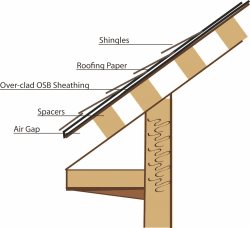This article discusses the different types of ventilation for sloped roofs, their environmental impacts, and their ventilation requirements.
Types of Natural Roof Ventilation
Below we list the two types of natural roof ventilation, with our definitions for each.
-
Attic Ventilation: Air intake at the eave, into a common attic space area, and exhaust through the ridge.
-
Above Sheathing Ventilation (ASV): Vented nailbase is a common type of ASV that consists of sheathing, spacers, and insulation that create an eave-to-ridge air space used for ventilation.


Thermal Effects
Warm air rises and cool air descends. While cool air enters the roof system through lower eave vents, the warmer air will naturally rise and exhaust via the higher ridge vents. Well-balanced ventilation systems utilize this natural thermal movement.
The Impact of Wind
When wind hits a building, high pressures force air in at the eave. As wind goes over a building, low pressures draw air out at the ridge and prevent rain and snow from entering. This happens because wind moving against and over a building creates high-pressure and low-pressure zones, also known as Bernoulli’s Principle, which states that “within a horizontal flow of fluid, points of higher fluid speed will have less pressure than points of slower fluid speed.” For a more details, review how the speed of a fluid relates to the pressure of the fluid and analysis of Bernoulli’s Principle from NASA.
Net Free Area (NFA)
Net Free Area is an important component for all roof ventilation. NFA represents the portion of the opening in the vent that actually ventilates – more specifically – the total unobstructed area through which air can enter or exhaust a non-powered vent.
Building Code Requirements (Commercial vs. Residential)
Commercial and residential building code requirements are actually very similar. However, commercial buildings are usually much larger and require a greater amount of ventilation.

Questions on proper ventilation? Reach out to our team of experts today!